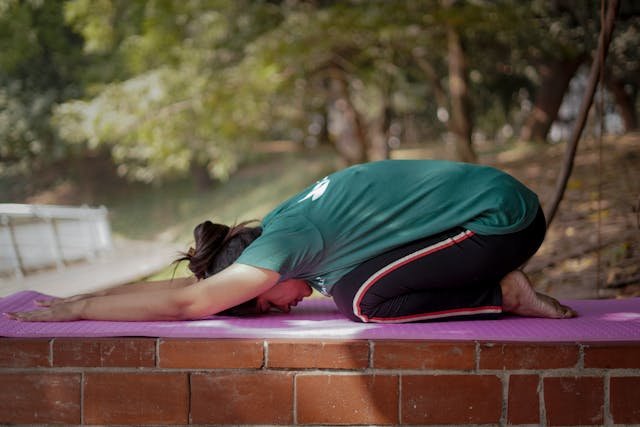
Zen Zone in Month Four: The Perfect Time for Prenatal Yoga
Feeling that second-trimester energy boost? Around week 13, many women begin to experience some welcome relief from those first three months of fatigue and morning sickness. That means it could be an ideal time to explore new things, like prenatal yoga. This gentle practice offers a beautiful way to connect with your body and your growing baby.
Find Your Flow in the Second Trimester
Yoga’s roots trace back thousands of years to ancient India, where it was developed as a holistic practice for physical, mental, and spiritual well-being. Its focus on mindfulness, breathwork, and gentle movement has made it a popular form of exercise and stress relief across the globe.
During the early stages of pregnancy, you might not feel ready for it—and that’s perfectly fine. If you’re new to yoga, the effects of hormonal shifts, nausea, and fatigue can make you less inclined to give it a try. As those initial pregnancy discomforts begin to ease in month four, you may find yourself more open to exploring prenatal yoga, which can gently support your physical and emotional well-being as your pregnancy progresses.
Benefits of Prenatal Yoga
Prenatal yoga isn’t just about stretching and breathing (although those are great perks!). It’s a holistic practice that nurtures both you and your baby-to-be:
Relieves Stress
As you may already know, pregnancy can be a whirlwind of emotions. Yoga helps you find your calm and reduce stress.
Promotes Strength and Flexibility
Gentle stretches and poses help keep you strong and limber, easing those aches and pains that come with carrying a little one.
Improves Circulation
Yoga poses that encourage blood flow can help reduce swelling and leg cramps.
Contributes to Better Sleep
Relaxation techniques can work wonders for your sleep quality, which we all know is precious during pregnancy.
Builds Connections with Your Baby
Prenatal yoga fosters mindfulness and awareness of your body and your little one, deepening the bond you share.
Empowers You
As you build physical and inner strength, you gain confidence for your pregnancy journey.
Breathe Serenity
Focused breathing in prenatal yoga can help reduce stress and anxiety by calming the mind and promoting relaxation. Regular practice enhances mindfulness and concentration, which can be beneficial during labor and delivery.
Expands Your Support Circle
Many prenatal yoga classes create a welcoming space for moms-to-be to connect and share their experiences.
Prenatal Yoga: What to Expect
Prenatal yoga is designed for all levels, so don’t worry if you’ve never done yoga before. You’ll be guided through gentle stretches, breathing exercises, and relaxation techniques in a supportive and nurturing environment.
Most classes will focus on poses that are safe and comfortable for pregnant women, modifying or avoiding any movements that could put pressure on your belly or strain your back. You’ll likely encounter props like blocks and blankets to help you find the perfect alignment for your changing body.
While prenatal yoga is considered a safe pregnancy exercise by the American College of Obstetricians and Gynecologists, always talk to your doctor before beginning any exercise program. Your healthcare provider will know your health history and any potential risks involved with yoga or certain poses.
Popular Pregnancy Yoga Poses
Some of the common poses you may try in a prenatal yoga class include:
Cat-Cow Pose (Marjaryasana-Bitilasana)

This gentle spinal stretch helps alleviate back pain and enhance flexibility, easing tension in the lower back and promoting relaxation.
Warrior II Pose (Virabhadrasana II)

Warrior II is a standing pose that strengthens your legs and opens your hips, preparing your body for labor and delivery.
Triangle Pose (Trikonasana)

This pose stretches your hamstrings, hips, and spine while opening your chest and shoulders.
Child’s Pose (Balasana)

A restful pose that helps you relax and stretches your back and hips.
Modifications Are Your Friend
Be sure to modify poses if you’re feeling any discomfort. Listen to your body and honor its limitations. Your instructor can offer alternative poses or modifications to ensure your safety and comfort.
Staying Safe During Prenatal Yoga
While prenatal yoga is generally safe, it’s important to take certain precautions:
- Consult Your Doctor. Always check with your doctor before starting any new exercise routine during pregnancy.
- Hydrate. Drink plenty of water before, during, and after your practice to stay hydrated.
- Avoid Overexertion. Pace yourself, listen to your body, and take breaks when needed. Don’t push yourself too hard, especially as your pregnancy progresses. Yoga is not designed to be a competitive sport; it’s about self-awareness and being in tune with yourself.
- Avoid Certain Poses. A few poses should be avoided during pregnancy, such as deep twists, backbends, and inversions. If you’re concerned about the safety of any pose, ask your instructor. Also, hot yoga is not recommended during pregnancy.
Finding a Prenatal Yoga Class
Looking for prenatal yoga? Your local yoga studios, fitness centers, libraries, and community centers are great places to start. Be sure to seek classes specifically labeled as “prenatal” and taught by certified instructors who have experience working with expectant moms.
Don’t forget to tap into your network! Ask friends, family, or your OB/GYN for recommendations. You can also check social media groups or forums for local moms-to-be—they’re often buzzing with helpful tips and suggestions.
Namaste, Mama!
Whether you’re just starting to rock that cute little bump at eighteen weeks or your belly feels ready to pop at eight months, prenatal yoga can be a special way to connect with your body and your growing baby. It’s a journey of self-discovery and preparation for the incredible adventure of motherhood. So, roll out that yoga mat, breathe deeply, and embrace the benefits of this beautiful practice. You’ll be glowing from the inside out!
Read more about pregnancy
How to manage constipation in pregnancy?
Journey of parenting of being two to three




